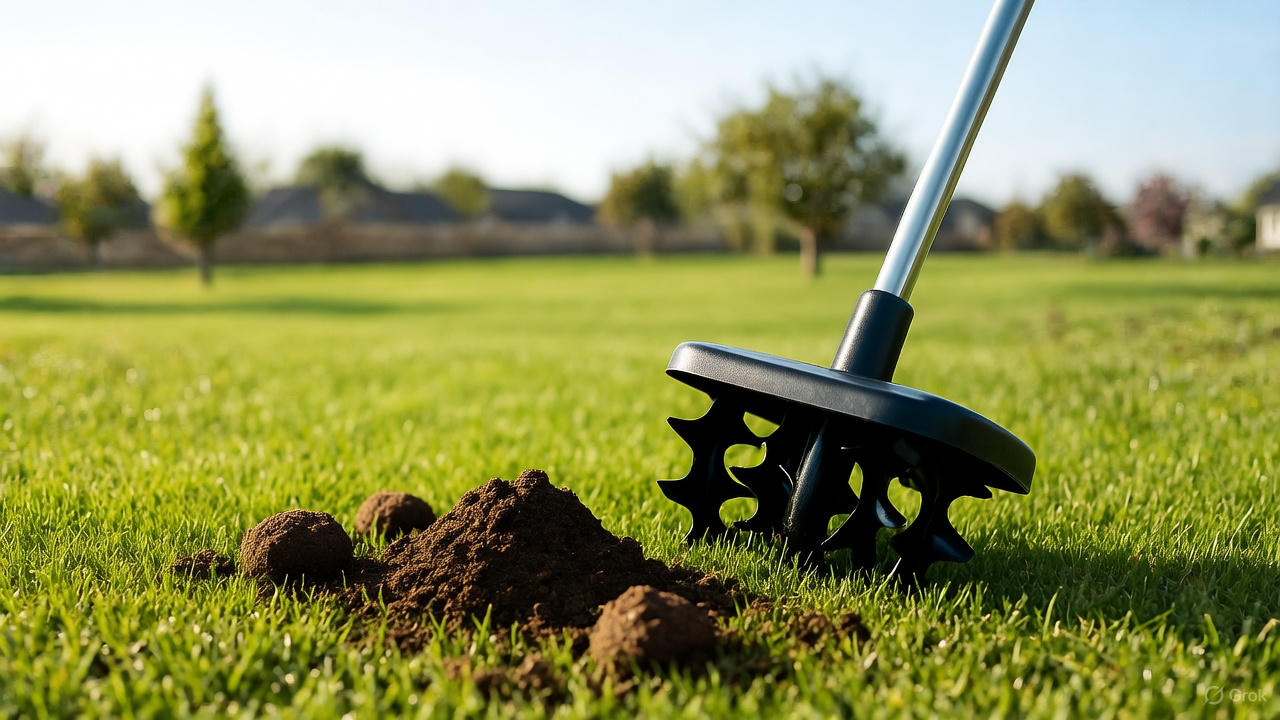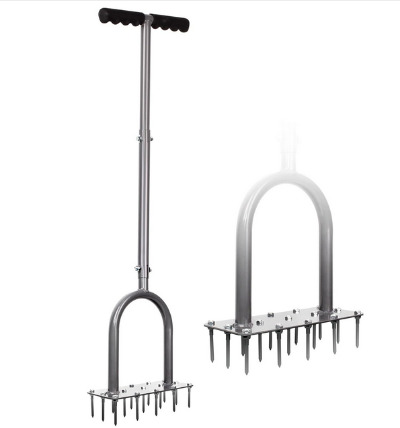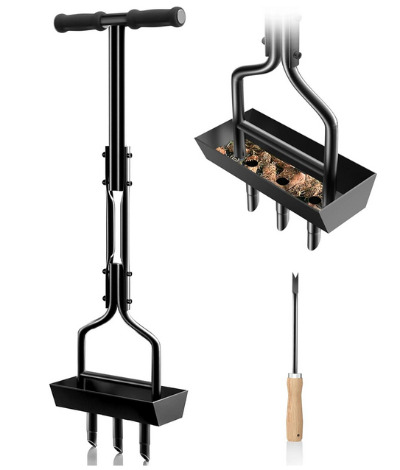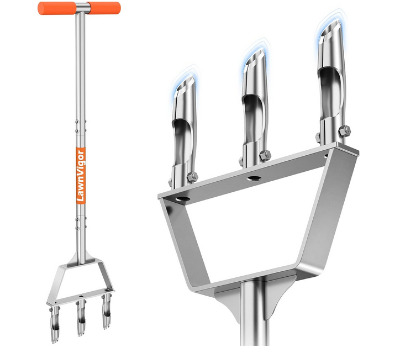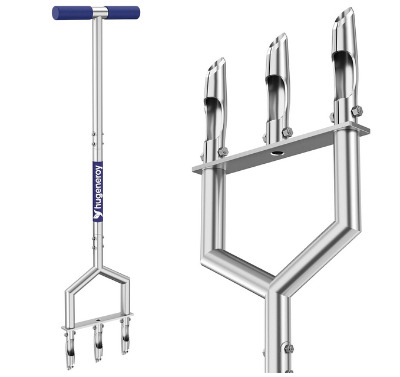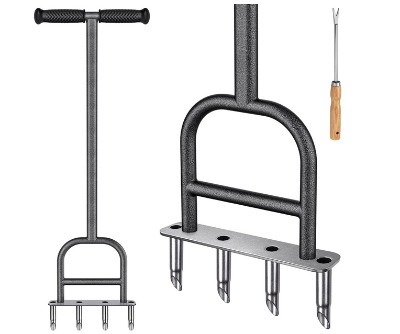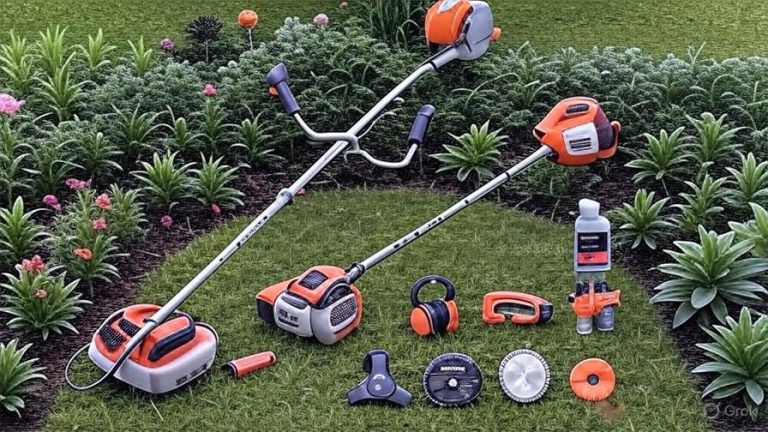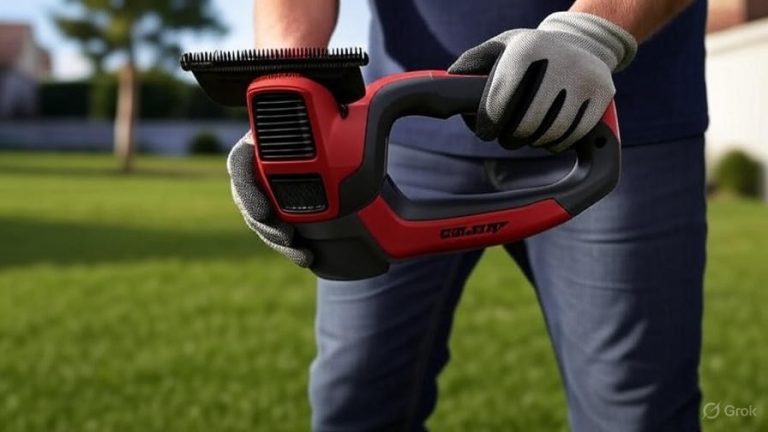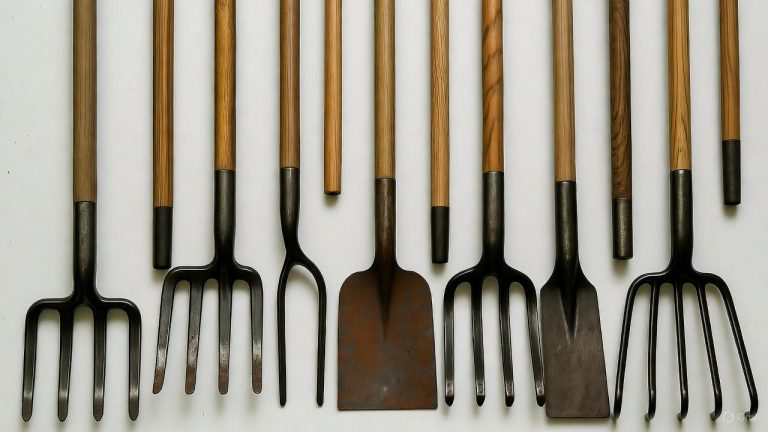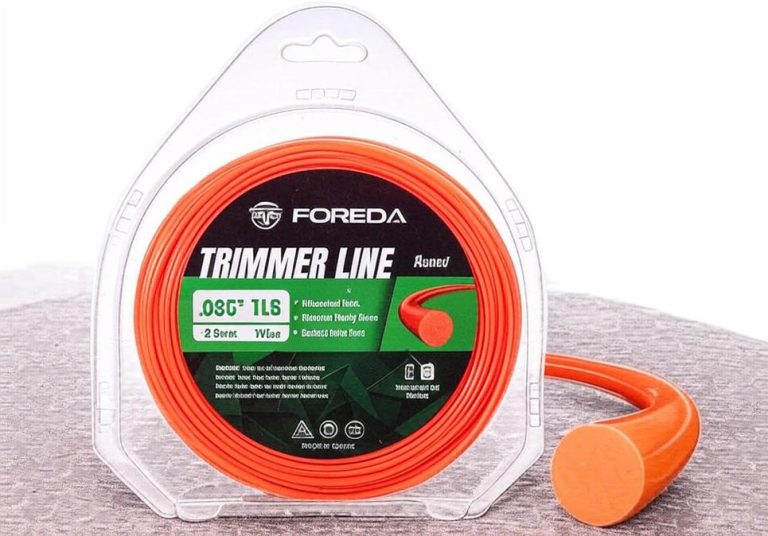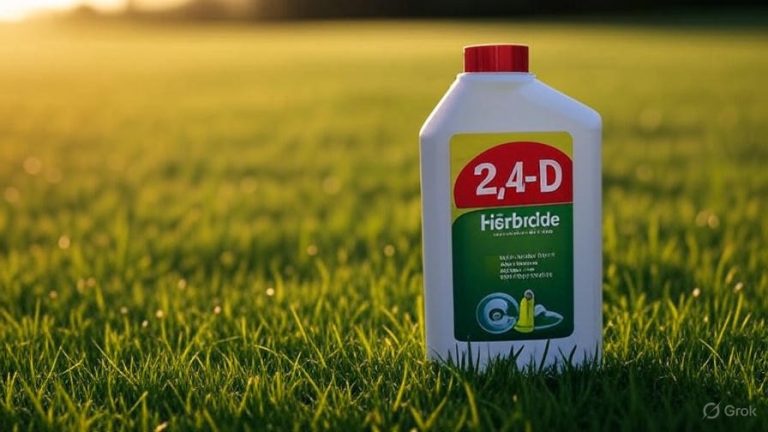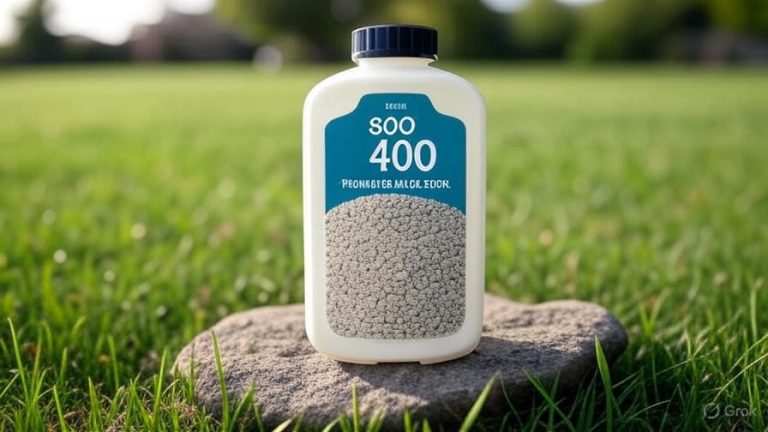5 Best Manual Lawn Aerator In 2025
A lush, vibrant lawn starts with proper soil aeration. Manual lawn aerators provide the foundation your grass needs to thrive by relieving soil compaction and improving nutrient absorption. These essential lawn care tools create pathways for air, water, and fertilizer to reach deep grass roots.
The market offers numerous manual aerator options, from basic spike models to sophisticated core removal systems. Each design serves specific lawn conditions and homeowner preferences. This comprehensive review examines the top five manual lawn aerators currently available, helping you make an informed decision for your yard care needs.
Manual Lawn Aeration: The Foundation of Healthy Grass
Soil compaction affects virtually every lawn, particularly in high-traffic areas where footsteps, equipment, and natural settling create dense, impermeable ground. Compacted soil prevents essential elements from penetrating to grass roots, resulting in thin, yellowing turf that struggles against weeds and disease.
Manual aeration tools address this problem by physically creating openings in the soil. These openings serve multiple purposes: they allow oxygen to reach root zones, improve water infiltration, and provide space for new root development. The process also helps break down thatch buildup, that layer of dead grass material that can suffocate healthy growth.
Professional landscapers and lawn care experts consistently recommend regular aeration as one of the most effective treatments for maintaining healthy grass. The practice becomes even more critical in areas with clay soils, heavy foot traffic, or lawns that receive minimal rainfall.
Spike vs Core Aeration: Understanding the Difference
Two primary aeration methods dominate the manual tool market: spike aeration and core aeration. Each approach offers distinct advantages and limitations that directly impact lawn health outcomes.
Spike aeration uses solid metal points to puncture holes directly into the soil. Spike aerators basically just poke holes into the soil and involve poking holes into the soil using any of a number of different garden tools. These tools work quickly and require less physical effort than core alternatives. However, spike aeration pushes soil into the ground, which could worsen compaction problems over time since spike aerators do not remove any soil.
Core aeration, conversely, physically removes cylindrical plugs of soil from the lawn. This produces good, solid plugs of soil that are great for breaking down and reusing as topsoil. Professional gardeners and lawn experts use tools to remove plugs of soil from lawns, and this has many benefits: aerates the soil, relieves soil compaction, improves drainage and drying.
The superiority of core aeration becomes evident in scientific comparisons. Core aeration almost always outperforms spike aeration because it actually reduces soil density rather than potentially increasing it.
Key Features to Consider in Manual Aerators
Successful lawn aeration depends on several critical design elements that separate effective tools from disappointing purchases. Understanding these features helps identify aerators that deliver lasting value and consistent performance.
Tine Design and Construction
Tine quality determines both penetration effectiveness and tool longevity. Stainless steel tines resist corrosion and maintain sharp edges through repeated use. Hollow tines for core removal require precise engineering to cleanly extract soil plugs without clogging. With an all-steel design, beveled stem, and open-faced removable tines, manual aerator products provide durable and efficient means of reducing soil compaction.
Handle Ergonomics and Length
Proper handle design reduces user fatigue and increases aeration efficiency. Longer handles provide better leverage for penetrating hard soil, while ergonomic grips prevent hand strain during extended use. Some models incorporate foot platforms that allow users to apply their full body weight for maximum penetration power.
Soil Storage and Cleaning Systems
Core aerators that include soil collection baskets streamline the cleanup process. These systems prevent loose soil plugs from scattering across the lawn while providing easy disposal options. Integrated cleaning tools help maintain tine sharpness and prevent clogging during operation.
Build Quality and Durability
Heavy-duty construction materials ensure tools survive seasons of demanding use. Welded steel frames resist bending under pressure, while quality hardware prevents premature component failure. The best aerators balance strength with reasonable weight for comfortable operation.
1: Walensee Lawn Aerator Spike Metal Manual Dethatching Tool
The Walensee spike aerator represents an entry-level approach to lawn aeration with its 15 iron spikes pre-assembled design. This tool targets homeowners seeking basic soil loosening without the complexity of core removal systems.
Design and Construction
The Walensee features a simple but effective spike design with 15 strategically positioned iron spikes. The pre-assembled construction eliminates setup time, allowing immediate use upon delivery. The metal frame provides adequate durability for typical residential applications.
The spike arrangement covers a reasonable working width, enabling efficient coverage of moderate lawn areas. Each spike measures sufficient length to penetrate most soil types, though performance varies significantly with soil conditions and moisture content.
Performance Analysis
Spike aeration naturally limits this tool’s effectiveness compared to core alternatives. The Walensee performs adequately in loose, sandy soils but struggles with clay or heavily compacted areas. Users report mixed results, with some experiencing improved water absorption while others notice minimal change in grass health.
The tool excels in speed of operation. A typical lawn treatment requires significantly less time than core aeration methods. This advantage appeals to homeowners with limited time or physical capabilities who need basic soil loosening.
Pros and Cons
Advantages include immediate usability, lightweight design, and affordable pricing. The simple construction reduces maintenance requirements and provides reliable operation for basic needs.
Limitations center around the fundamental restrictions of spike aeration. The tool may actually increase soil compaction in certain conditions, particularly in clay soils or areas with existing compaction problems. Penetration depth varies considerably with soil conditions, potentially limiting effectiveness.
Best Use Cases
The Walensee works best for maintenance aeration in relatively healthy lawns with sandy or loam soils. It suits homeowners seeking minimal investment in lawn care tools or those with small yard areas that don’t justify larger equipment purchases.
2: Manual Lawn Aerator Tool with Soil Storage Basket
This upgraded aerator incorporates core removal technology with practical convenience features. The soil storage basket addresses one of the primary complaints about core aeration: the mess of soil plugs scattered across the lawn.
Design and Construction
The 38-inch ergonomic handle provides excellent leverage while reducing back strain during operation. Three hollow tines create clean soil plugs while the integrated storage basket collects removed material for easy disposal. A dedicated cleaning tool maintains tine efficiency throughout use.
Construction quality emphasizes durability with reinforced connection points and heavy-duty tine materials. The basket design allows continued operation without frequent emptying, improving workflow efficiency.
Performance Analysis
Core removal delivers superior results compared to spike alternatives. Users consistently report improved water penetration, enhanced fertilizer absorption, and visible grass health improvements within weeks of treatment. The three-tine design provides manageable operation while maintaining effective soil removal.
The soil collection system performs as advertised, capturing most removed plugs and preventing lawn debris. The cleaning tool proves essential for maintaining tine function in clay soils or during extended use sessions.
Pros and Cons
Major advantages include genuine core removal, convenient soil collection, and ergonomic design that reduces user fatigue. The included cleaning tool adds significant value by maintaining peak performance throughout use.
Potential drawbacks involve higher physical demands compared to spike aerators and the need for proper technique to achieve optimal results. The tool requires more storage space than simpler alternatives.
Best Use Cases
This aerator suits homeowners with moderate to severe soil compaction issues who want professional-quality results without power equipment. The soil collection feature particularly benefits users who maintain pristine lawn appearances.
3: Manual Core Aerator Lawn Tool with Replaceable Hollow Tines
The orange manual core aerator emphasizes tine replaceability and semi-assembled design for user customization. This approach appeals to homeowners who prefer some assembly involvement and want long-term tine replacement options.
Design and Construction
Semi-assembled design allows users to verify component quality and understand tool mechanics. Three replaceable hollow tines provide standard core removal capability while the replacement feature ensures continued effectiveness as tines wear.
The construction balances durability with reasonable weight, making the tool manageable for most users while providing sufficient strength for demanding soil conditions. Assembly requirements remain straightforward with basic tools.
Performance Analysis
Core removal performance matches expectations for three-tine designs. The replaceable tine system maintains effectiveness over time, addressing the common problem of worn or damaged tines that reduce aeration quality.
User reports indicate satisfactory penetration in most soil types, with particularly good results in loam and sandy clay conditions. The tool struggles in heavily compacted clay without pre-moistening.
Pros and Cons
The replaceable tine system provides the primary advantage, offering long-term value through component replacement rather than complete tool replacement. Semi-assembled design allows quality verification and easier storage.
Disadvantages include assembly requirements that may discourage some users and the need to source replacement tines when originals wear out. The bright orange color may not appeal to all aesthetic preferences.
Best Use Cases
This tool works well for mechanically-inclined homeowners who appreciate the replaceable tine concept and don’t mind basic assembly. The replacement capability makes it suitable for extensive use or commercial applications where tine wear occurs frequently.
4: Manual Push Core Aerator Lawn Tool in Blue
The blue manual push aerator offers similar core removal technology with its own design interpretation. This semi-assembled tool provides three replaceable hollow tines in an alternative color scheme.
Design and Construction
The blue finish distinguishes this model while providing identical functionality to similar designs. Semi-assembled construction follows industry standards with straightforward assembly using basic tools. Three replaceable hollow tines offer standard core removal capability.
Build quality appears consistent with comparable products, featuring adequate materials for residential use and reasonable durability expectations. The design incorporates standard ergonomic principles without revolutionary features.
Performance Analysis
Performance closely parallels other three-tine core aerators in this category. Users report satisfactory soil plug removal in appropriate conditions with typical limitations in extremely hard or clay soils.
The replaceable tine system functions as designed, though long-term availability of replacement parts remains uncertain without established distribution networks.
Pros and Cons
Advantages mirror those of similar products: effective core removal, replaceable tines, and reasonable construction quality. The blue color provides an alternative aesthetic option.
Limitations include standard challenges of manual core aeration: physical demands, technique requirements, and variable performance based on soil conditions.
Best Use Cases
This tool suits homeowners seeking core aeration capability with color preferences different from orange alternatives. The replaceable tine feature appeals to users planning long-term tool ownership.
5: Dolibest Lawn Coring Aerator with Stainless Steel Construction
The Dolibest represents premium manual aeration with its four-corer design and stainless steel construction. This tool targets users willing to invest in superior materials and expanded capability.
Design and Construction
Stainless steel construction provides superior corrosion resistance and long-term durability compared to standard steel alternatives. The four-corer design increases productivity by removing more soil with each operation cycle.
Soft rubber grip handles enhance user comfort during extended use while the cleaning hand tool maintains peak performance. The overall construction quality exceeds most manual aerators in this category.
Performance Analysis
Four-corer design significantly improves productivity compared to three-tine alternatives. Users can aerate larger areas in less time while maintaining effective core removal. The stainless steel tines resist wear and maintain sharp edges through extended use.
Performance in various soil conditions generally exceeds three-tine models, with the additional corer providing better distribution of soil removal and improved overall effectiveness.
Pros and Cons
Stainless steel construction offers the primary advantage with superior durability and corrosion resistance. The four-corer design increases efficiency while the soft grip handles improve user comfort.
Higher cost represents the main disadvantage, potentially placing the tool beyond budget-conscious buyers. The increased number of corers also requires slightly more maintenance attention.
Best Use Cases
This aerator suits homeowners planning extensive use or those prioritizing long-term durability over initial cost savings. The four-corer design particularly benefits larger lawn areas where productivity matters.
Comparing Manual Aerator Types: Spike vs Core Performance
The fundamental difference between spike and core aeration creates distinct performance profiles that affect lawn health outcomes. Understanding these differences helps homeowners select the most appropriate tool for their specific conditions.
Spike aerators worked more effectively in heavily compacted and dry soils when the user’s entire weight bears down on just two spikes instead of six or eight spikes at a time. However, this advantage comes with significant limitations.
Spike aerators are cheaper but they increase soil compaction and don’t really accomplish much, while core aerators lessen soil compaction and promote better root growth. This fundamental difference explains why lawn care professionals consistently recommend core aeration for serious soil improvement.
Core aeration provides measurable benefits that spike alternatives cannot match. Aerator coring encourages healthy root growth, enhances resistance to drought and flooding and reduces the need for excessive amounts of fertilizer. These long-term advantages justify the additional effort and cost associated with core removal tools.
Soil Conditions and Tool Selection
Different soil types respond uniquely to various aeration methods. Clay soils, sandy loams, and mixed compositions each present distinct challenges that influence tool effectiveness.
Clay soils represent the most challenging conditions for manual aeration. These dense, fine-grained soils resist penetration and may actually become more compacted under spike aeration pressure. Core removal provides the only effective solution for severely compacted clay, though pre-moistening often proves necessary for successful operation.
Sandy soils allow easier penetration but may not require aggressive aeration methods. Spike aerators often provide sufficient soil loosening in sandy conditions, while core removal may be unnecessary unless severe compaction exists.
Loam soils, the ideal growing medium, respond well to both aeration methods. However, core removal still provides superior long-term benefits even in these favorable conditions.
Proper Aeration Technique and Timing
Successful manual aeration requires proper technique and timing to achieve optimal results. Many homeowners achieve disappointing outcomes due to incorrect application rather than tool limitations.
Soil Preparation
Soil moisture content critically affects aeration success. Bone-dry soil resists penetration while overly wet conditions create muddy messes and poor core formation. The ideal moisture level allows easy penetration while maintaining soil structure for clean core removal.
Watering dry lawns 24-48 hours before aeration typically creates optimal conditions. The soil should feel moist but not soggy, with plugs holding together without being sticky.
Application Patterns
Systematic application patterns ensure complete coverage while preventing excessive soil disturbance. Most experts recommend 6-inch spacing between holes, though heavily compacted areas may require closer spacing.
Overlapping passes in perpendicular directions provide the most thorough treatment. This cross-hatching pattern ensures no areas escape aeration while distributing soil removal evenly across the lawn.
Post-Aeration Care
Watering settles soil, replenishes moisture lost during aeration, supports quick lawn recovery, and enhances aeration benefits to promote healthier grass growth. Proper post-aeration care maximizes the benefits of the aeration process.
Leaving soil plugs on the lawn surface allows beneficial microorganisms to break down the removed soil, adding organic matter back to the lawn. These plugs typically disappear within 2-4 weeks through natural decomposition and weather action.
Seasonal Considerations for Manual Aeration
Timing aeration activities according to grass type and local climate conditions optimizes results while minimizing plant stress. Cool-season and warm-season grasses require different approaches due to their distinct growth patterns.
Cool-season grasses benefit most from fall aeration, typically performed in September or early October. This timing allows grass to recover before winter dormancy while taking advantage of favorable growing conditions as temperatures moderate.
Spring aeration also works for cool-season grasses, particularly in northern climates where fall weather may not provide adequate recovery time. However, avoid aeration during summer stress periods when cool-season grasses struggle with heat and drought.
Warm-season grasses perform best with late spring or early summer aeration, coinciding with their active growing period. These grasses can recover quickly from aeration stress when temperatures and growing conditions are optimal.
Maintenance and Storage of Manual Aerators
Proper maintenance extends aerator life while ensuring consistent performance throughout the tool’s service period. Simple care procedures prevent premature wear and maintain effectiveness.
Cleaning and Inspection
Thorough cleaning after each use prevents soil buildup and corrosion. Core aerators require particular attention to tine maintenance, ensuring hollow cores remain clear of debris. The included cleaning tools prove essential for this maintenance.
Regular inspection identifies worn or damaged components before they affect performance. Tine sharpness, handle integrity, and connection points all require periodic examination.
Storage Requirements
Dry storage prevents rust and corrosion that can destroy metal components. Indoor storage in garages or sheds provides the best protection, though outdoor storage requires weather protection and elevation off ground contact.
Replaceable tine models benefit from spare component storage, ensuring replacement parts remain available when needed.
Cost Analysis: Value Considerations
Manual aerator prices range from budget-friendly spike models under $50 to premium core removal systems exceeding $150. Understanding the relationship between cost and performance helps justify investment decisions.
Spike aerators offer the lowest initial cost but may provide limited long-term value due to their fundamental limitations. These tools work for maintenance applications but cannot address serious soil compaction issues.
Core removal aerators require higher initial investment but deliver superior results that justify the additional cost. The ability to actually reduce soil compaction rather than potentially worsening it makes these tools essential for serious lawn improvement.
Premium materials like stainless steel construction command higher prices but provide extended service life and better performance. The cost difference often proves worthwhile for users planning extensive or long-term use.
Professional vs DIY Aeration: Making the Decision
Manual aerators enable homeowners to perform professional-quality lawn aeration without hiring landscape services. However, the decision between DIY and professional treatment involves several considerations beyond simple cost comparison.
Physical demands represent a primary factor in the DIY decision. Manual aeration requires significant physical effort, particularly in compacted soils or large lawn areas. Users with physical limitations may find professional services more practical despite higher costs.
Time investment also affects the decision. Manual aeration takes considerable time, especially for thorough treatment of larger lawns. Homeowners with limited time may prefer professional services that complete the job quickly with powered equipment.
Control over timing and technique provides the primary advantage of manual aeration. Homeowners can aerate exactly when conditions are optimal and ensure thorough coverage of problem areas.
Environmental Benefits of Manual Aeration
Manual lawn aeration provides environmental advantages beyond immediate grass health improvements. These tools support sustainable lawn care practices while reducing reliance on chemical treatments and resource consumption.
Improved soil structure reduces fertilizer requirements by increasing nutrient absorption efficiency. Core aeration reduces the need for excessive amounts of fertilizer while promoting natural soil biology that supports plant health.
Enhanced water infiltration reduces runoff and irrigation requirements. Aerated soils capture and retain more rainfall, reducing the need for supplemental watering during dry periods.
Reduced thatch buildup decreases the need for chemical dethatcher applications while supporting natural decomposition processes that improve soil organic matter content.
Troubleshooting Common Aeration Problems
Even quality manual aerators can produce disappointing results when conditions or techniques are suboptimal. Understanding common problems and their solutions helps users achieve better outcomes.
Poor penetration often results from inappropriate soil moisture conditions. Excessively dry soil prevents adequate tine penetration while overly wet conditions create messy, ineffective operation. Adjusting moisture levels typically resolves penetration issues.
Incomplete core removal in core aerators usually indicates tine clogging or worn cutting edges. The cleaning tools included with quality aerators address these problems when used regularly during operation.
Uneven results across the lawn may reflect inconsistent application pressure or spacing. Maintaining steady pressure and systematic patterns ensures uniform treatment throughout the lawn area.
The Future of Manual Lawn Aeration
Manual aeration tools continue evolving with improved materials, ergonomic designs, and user-friendly features. These developments make manual aeration more accessible while improving results for homeowners.
Stainless steel construction becomes increasingly common as manufacturers recognize the durability advantages. This trend provides better value through extended tool life despite higher initial costs.
Ergonomic improvements reduce user fatigue and make manual aeration accessible to broader populations. Better handle designs, weight distribution, and leverage systems continue developing.
Integrated features like soil collection systems and cleaning tools address user convenience while maintaining focus on core aeration effectiveness.
Conclusion: Choosing Your Ideal Manual Aerator
The best manual lawn aerator depends on your specific needs, soil conditions, and commitment to lawn health improvement. This comprehensive review reveals that core removal aerators consistently outperform spike alternatives for serious soil improvement, though spike models may suffice for basic maintenance applications.
For homeowners seeking professional results, the Dolibest Lawn Coring Aerator offers superior construction with its four-corer stainless steel design. The additional investment provides enhanced durability and improved productivity that justify the higher cost.
Budget-conscious buyers who still want effective core removal should consider the Manual Lawn Aerator Tool with Soil Storage Basket. This tool provides genuine core removal capability with convenient features at a reasonable price point.
The Manual Core Aerator tools with replaceable tines appeal to users planning long-term ownership who appreciate the ability to maintain peak performance through component replacement.
Spike aerators like the Walensee model serve homeowners with minimal soil compaction issues who prioritize speed and simplicity over maximum effectiveness.
Regardless of your choice, proper technique and timing remain crucial for achieving optimal results. Manual aeration requires physical effort and patience, but the rewards of healthier, more resilient grass make the investment worthwhile.
Remember that lawn aeration is not a one-time solution but an ongoing maintenance practice. Regular aeration, typically performed annually or biannually depending on soil conditions, provides cumulative benefits that transform struggling lawns into thriving landscapes.
The tools reviewed here represent the current state of manual aeration technology, offering options for every budget and application. Your lawn’s health improvements will validate your investment in proper aeration equipment and technique.

